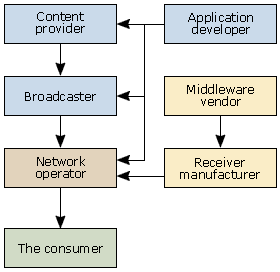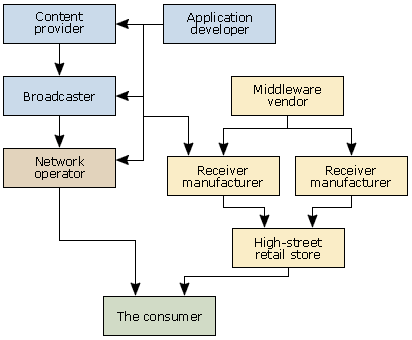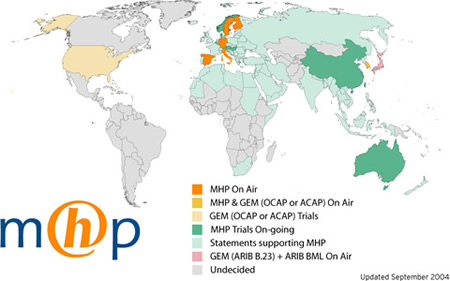The Digital Video Broadcasting consortium is an industry consortium that standardizes various aspects of digital TV broadcasting. In the past, they’ve standardized issues such as how digital TV signals are transmitted over cable, satellite or terrestrial broadcasting networks, how information describing a digital TV transmission is encoded in the bitstream, and generally how to make the various parts of a digital TV system work together.
They’ve been doing this for several years now, and DVB standards are pretty widely used across Europe and Asia, with some take-up in the US. The DVB web site’s page on the use of DVB standards worldwide gives you an idea of how many countries are now using DVB standards. A couple of years ago, they started to get the ball rolling on an open standard for interactive digital TV.
There have been attempts to do this before, by ISO with the MHEG standards, by DAVIC, and by ATSC with the DASE standard. Unfortunately these were not very successful for a variety of reasons, but DVB’s attempt seems to have been timed just about right. Previous standards had either been finalized just at the start of the Java wave, or as attempts to extend and adapt older standards to include Java. These timing issues meant that their chances of success were greatly reduced, but the world wasn’t really ready for an open standard at that time.
These older open standards are still used in some cases (e.g. one of the UK digital broadcasters uses MHEG), but companies like OpenTV, NDS, and Microsoft (who have proprietary iTV solutions) still dominate the iTV market at the moment.
MHP is an attempt to change this. In it’s simplest form, it’s a set of Java APIs that let you write interoperable applications. These are broadcast as part of the MPEG-2 stream that makes up a digital TV signal, and an MHP-compliant receiver can run these applications on your TV. Since MHP uses Java (and some API extensions that are specific to digital TV), you can do almost anything you want to.
People have written MHP games, information services and electronic program guides, as well as news tickers, stock tickers and services related to TV shows such as sports broadcasts. I don’t have the rights to show any of these applications here, but the example applications page on the MHP site shows a small selection of what’s out there. There are lots of others that aren’t shown there, but that’s a pretty good selection. MHP is starting to become more widely adopted, at least by governments and public terrestrial broadcasters. It’s still got a long way to go in the area of commercial broadcasting (e.g. cable and satellite operators), but it’s making a few inroads. The map below (taken from the MHP web site) shows MHP adoption worldwide:
Adoption of MHP worldwide. Source: the DVB web site.
OK, so you there’s an open standard out there that’s starting to compete with the existing proprietary solutions. So what? What does MHP have to offer over the current solutions?
Before we answer this, lets take a look at the content delivery chain for a digital TV signal. This particular diagram illustrates a situation that’s fairly common at the moment:
A vertical (closed) market for digital television.

This a vertical market – the broadcasters rent the set-top boxes to the consumer as part of the subscription deal, which means that they control the specification for the receivers. So, all the receiver manufacturers can do is build boxes to the specification of the broadcaster, and all the consumer can do is take the box that the broadcaster provides to them.
Since the broadcasters control the receiver specification, they also control the applications that will run on those receivers by their choice of middleware. Since different broadcasters can choose different middleware systems, a content provider may have to re-author any applications if they want to sell that content to other broadcasters.
So, in the current DTV markets, the broadcasters are pretty much full control , and everyone else has to go along with their decisions. Which is good for the broadcasters, right? Yes and no. The broadcasters get the control, but because they own the receivers, that can mean that a lot of capital is invested in hardware and the associated costs (maintaining inventory, technical support, upgrades and replacements, etc.)
For this reason, this situation isn’t necessarily that desirable for the broadcasters. Ideally, they would like to dump these kinds of costs on to someone else. So the people who actually have the least risk in this situation is the middleware supplier, since there aren’t many proprietary middleware vendors and no-one really wants to develop a new middleware stack on their own. The cost of competing with companies like NDS, OpenTV, and Canal+ is so high that very few companies can afford to do it, especially since existing middleware vendors have pre-existing relationships with broadcasters, STB vendors, CA companies and other players in the DTV business.
Now that we’ve seen the vertical market, let’s look at the picture of how an open standard would work in an ideal
world:
A horizontal (open) market for digital television.

In this case, the consumer can buy a receiver from any electronics store and expect it to work with any digital TV broadcaster, just like the current situation with analogue broadcasting. The subscription to the broadcaster simply gets the consumer a decryption module that allows you to watch the broadcasts. The user now no longer requires a separate set-top box for every broadcaster that he or she wishes to subscribe to, so it’s possible to subscribe to different broadcasters for different packages in a much easier way than is currently possible.
Since the broadcaster no longer controls the specification of the receivers, receiver manufacturers are in a better position to add value and compete with each other, driving improvements for the customer. Similarly, since the middleware is now standardized and open, content developers can distribute their content to more broadcasters without having to re-author all their applications.
Middleware vendors are the people who suffer most in this picture, because the barrier to entry is now much lower and it’s easier for new companies to implement middleware and compete with existing vendors. This drives down the cost of the middleware, but it is also likely to dramatically increase the size of the overall market as broadcasters who can’t use proprietary middleware solutions (e.g. public broadcasters) start to deploy digital services.
Ideal worlds are nothing like the real world, of course, and so this situation isn’t one that’s likely to happen any time soon. The more likely scenario is a mixture of horizontal and vertical markets where broadcasters use open standards for the middleware. This enables the content developers to sell their content without having to re-author it, and makes life easier for receiver manufacturers, since they have a wider choice of middleware suppliers.
In the long run, this model would probably move closer to our ideal situation, but this will take some time.
So, having learned a little of the politics and reasons behind MHP, hopefully the rest of this site can give you some more information about the MHP standard. This site assumes that you know at least a little about digital TV broadcasting and in particular DVB. If you’re unfamiliar with any of the following terms, it’s probably best if you take a look at the introduction to digital broadcasting before exploring the rest of the site:
- DVB service
- Service information
- Section filter
- MPEG-2
- Transport stream
- DSM-CC
- Object carouse

